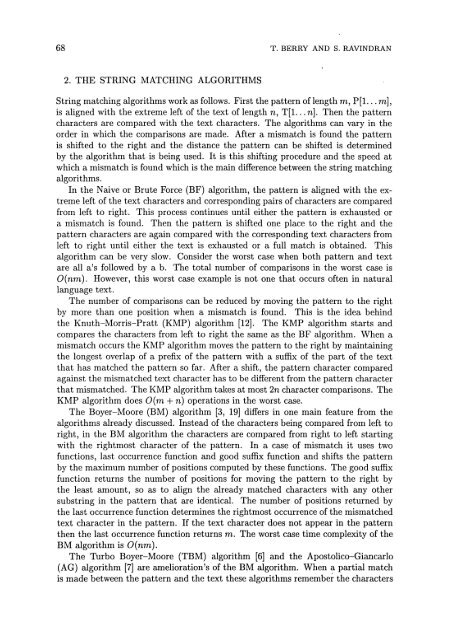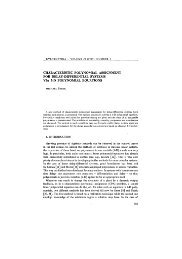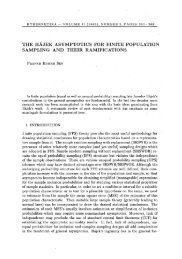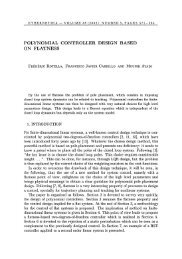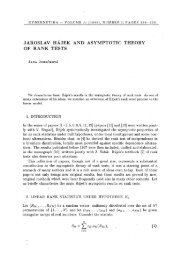tuning the zhu-takaoka string matching algorithm and ... - Kybernetika
tuning the zhu-takaoka string matching algorithm and ... - Kybernetika
tuning the zhu-takaoka string matching algorithm and ... - Kybernetika
Create successful ePaper yourself
Turn your PDF publications into a flip-book with our unique Google optimized e-Paper software.
68 T. BERRY AND S. RAVINDRAN<br />
2. THE STRING MATCHING ALGORITHMS<br />
String <strong>matching</strong> <strong>algorithm</strong>s work as follows. First <strong>the</strong> pattern of length m, P[l... m],<br />
is aligned with <strong>the</strong> extreme left of <strong>the</strong> text of length n, T[l... n]. Then <strong>the</strong> pattern<br />
characters are compared with <strong>the</strong> text characters. The <strong>algorithm</strong>s can vary in <strong>the</strong><br />
order in which <strong>the</strong> comparisons are made. After a mismatch is found <strong>the</strong> pattern<br />
is shifted to <strong>the</strong> right <strong>and</strong> <strong>the</strong> distance <strong>the</strong> pattern can be shifted is determined<br />
by <strong>the</strong> <strong>algorithm</strong> that is being used. It is this shifting procedure <strong>and</strong> <strong>the</strong> speed at<br />
which a mismatch is found which is <strong>the</strong> main difference between <strong>the</strong> <strong>string</strong> <strong>matching</strong><br />
<strong>algorithm</strong>s.<br />
In <strong>the</strong> Naive or Brute Force (BF) <strong>algorithm</strong>, <strong>the</strong> pattern is aligned with <strong>the</strong> extreme<br />
left of <strong>the</strong> text characters <strong>and</strong> corresponding pairs of characters are compared<br />
from left to right. This process continues until ei<strong>the</strong>r <strong>the</strong> pattern is exhausted or<br />
a mismatch is found. Then <strong>the</strong> pattern is shifted one place to <strong>the</strong> right <strong>and</strong> <strong>the</strong><br />
pattern characters are again compared with <strong>the</strong> corresponding text characters from<br />
left to right until ei<strong>the</strong>r <strong>the</strong> text is exhausted or a full match is obtained. This<br />
<strong>algorithm</strong> can be very slow. Consider <strong>the</strong> worst case when both pattern <strong>and</strong> text<br />
are all a's followed by a b. The total number of comparisons in <strong>the</strong> worst case is<br />
0(nm). However, this worst case example is not one that occurs often in natural<br />
language text.<br />
The number of comparisons can be reduced by moving <strong>the</strong> pattern to <strong>the</strong> right<br />
by more than one position when a mismatch is found. This is <strong>the</strong> idea behind<br />
<strong>the</strong> Knuth-Morris-Pratt (KMP) <strong>algorithm</strong> [12]. The KMP <strong>algorithm</strong> starts <strong>and</strong><br />
compares <strong>the</strong> characters from left to right <strong>the</strong> same as <strong>the</strong> BF <strong>algorithm</strong>. When a<br />
mismatch occurs <strong>the</strong> KMP <strong>algorithm</strong> moves <strong>the</strong> pattern to <strong>the</strong> right by maintaining<br />
<strong>the</strong> longest overlap of a prefix of <strong>the</strong> pattern with a suffix of <strong>the</strong> part of <strong>the</strong> text<br />
that has matched <strong>the</strong> pattern so far. After a shift, <strong>the</strong> pattern character compared<br />
against <strong>the</strong> mismatched text character has to be different from <strong>the</strong> pattern character<br />
that mismatched. The KMP <strong>algorithm</strong> takes at most 2n character comparisons. The<br />
KMP <strong>algorithm</strong> does 0(m-\-n) operations in <strong>the</strong> worst case.<br />
The Boyer-Moore (BM) <strong>algorithm</strong> [3, 19] differs in one main feature from <strong>the</strong><br />
<strong>algorithm</strong>s already discussed. Instead of <strong>the</strong> characters being compared from left to<br />
right, in <strong>the</strong> BM <strong>algorithm</strong> <strong>the</strong> characters are compared from right to left starting<br />
with <strong>the</strong> rightmost character of <strong>the</strong> pattern. In a case of mismatch it uses two<br />
functions, last occurrence function <strong>and</strong> good suffix function <strong>and</strong> shifts <strong>the</strong> pattern<br />
by <strong>the</strong> maximum number of positions computed by <strong>the</strong>se functions. The good suffix<br />
function returns <strong>the</strong> number of positions for moving <strong>the</strong> pattern to <strong>the</strong> right by<br />
<strong>the</strong> least amount, so as to align <strong>the</strong> already matched characters with any o<strong>the</strong>r<br />
sub<strong>string</strong> in <strong>the</strong> pattern that are identical. The number of positions returned by<br />
<strong>the</strong> last occurrence function determines <strong>the</strong> rightmost occurrence of <strong>the</strong> mismatched<br />
text character in <strong>the</strong> pattern. If <strong>the</strong> text character does not appear in <strong>the</strong> pattern<br />
<strong>the</strong>n <strong>the</strong> last occurrence function returns m. The worst case time complexity of <strong>the</strong><br />
BM <strong>algorithm</strong> is 0(nm).<br />
The Turbo Boyer-Moore (TBM) <strong>algorithm</strong> [6] <strong>and</strong> <strong>the</strong> Apostolico-Giancarlo<br />
(AG) <strong>algorithm</strong> [7] are amelioration's of <strong>the</strong> BM <strong>algorithm</strong>. When a partial match<br />
is made between <strong>the</strong> pattern <strong>and</strong> <strong>the</strong> text <strong>the</strong>se <strong>algorithm</strong>s remember <strong>the</strong> characters


